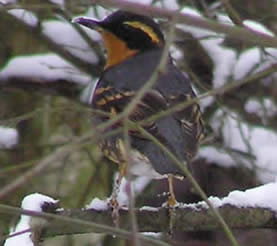

NATURE NOTES

Varied Thrush, photo by Hugh Griffith
Strange Voice from the High Country
by
Snow on the mountains, when there is any, does more than provide recreation for skiers and snowboarders. It has the added effect of enlivening winter for wildlife enthusiasts on the flatlands below. Certain alpine birds, unimpressed with the arrival of a winter wonderland, head to low ground where food can more easily be found.
One such species is the extremely shy, but very handsome, Varied Thrush, which scratches in leaf litter for invertebrates, seeds and fallen fruit. If you have walked along a forest trail in winter and a robin-sized, grayish flash erupted from the ground just ahead and disappeared into the canopy above, you have probably seen, sort of, a Varied Thrush.
They don't usually fly far, seldom more than 10 metres, and they land with their backs to you, glancing nervously over their shoulders to see if you are following. They then tend to repeat a soft, sad, "Hmph," sound, as though insulted or even wounded by your intrusion. Often there are two or more birds, all nervously waiting for you to move along.

Varied Thrush, back view, photo by Hugh Griffith
It's too bad that they give you the cold shoulder, for although owning very attractive backs, a slatey-blue not seen on other species, it is the front view that is the money shot, especially in the dimly-lit woods these birds favour. The throat and belly are flame-orange, interrupted by a thick black collar across the throat. Above the eye is an arching streak, also brilliant orange.
If you fancy yourself a photographer, want a challenge, and have shameless paparazzi tendencies, try to snap the elusive Varied Thrush face-on. Adding to the challenge, they tend to perch deep within trees, so even if able to see the front view, most likely you will be glimpsing it through a tangle of twigs. If you persist, the bird will lure you deep into the undergrowth, then fly away, leaving you struggling in the shrubbery.
During the recent snow I encountered one at a local park. I have a dozen pictures of its back, and one, with twigs, of its front.
As the days lengthen, and Varied Thrushes' interests turn to other Varied Thrushes, they reveal another unique feature. They are among the most peculiar songsters of the Pacific Coast forests. Their song consists of a chain of long, quavering notes that fade in and out, separated by long, deliberate pauses. Each note is either higher or lower than the preceding, giving the eerie effect of a disjointed series of randomly, or absent-mindedly selected minor chords. I haven’t heard one yet this year, but they should be singing within a few weeks.
Years ago I awoke to this song outside my bedroom window. I peeked through the blinds. It was a frostry morning with pink-orange light slanting through the branches. A Varied Thrush was perched on an apple tree only a few feet away, among the frozen remains of that year's crop. With every haunting note, a ribbon of mist curled from it's opened beak.
Now that would have been a picture.
Hugh Griffith is a BC zoologist and science writer.
Please cite these pages as:
Author, date, page title. In: Klinkenberg, Brian. (Editor) 2023. E-Fauna BC: Electronic Atlas of the Fauna of British Columbia [www.efauna.bc.ca]. Department of Geography, University of British Columbia, Vancouver. [Date Accessed]
© Copyright 2023 E-Fauna BC.